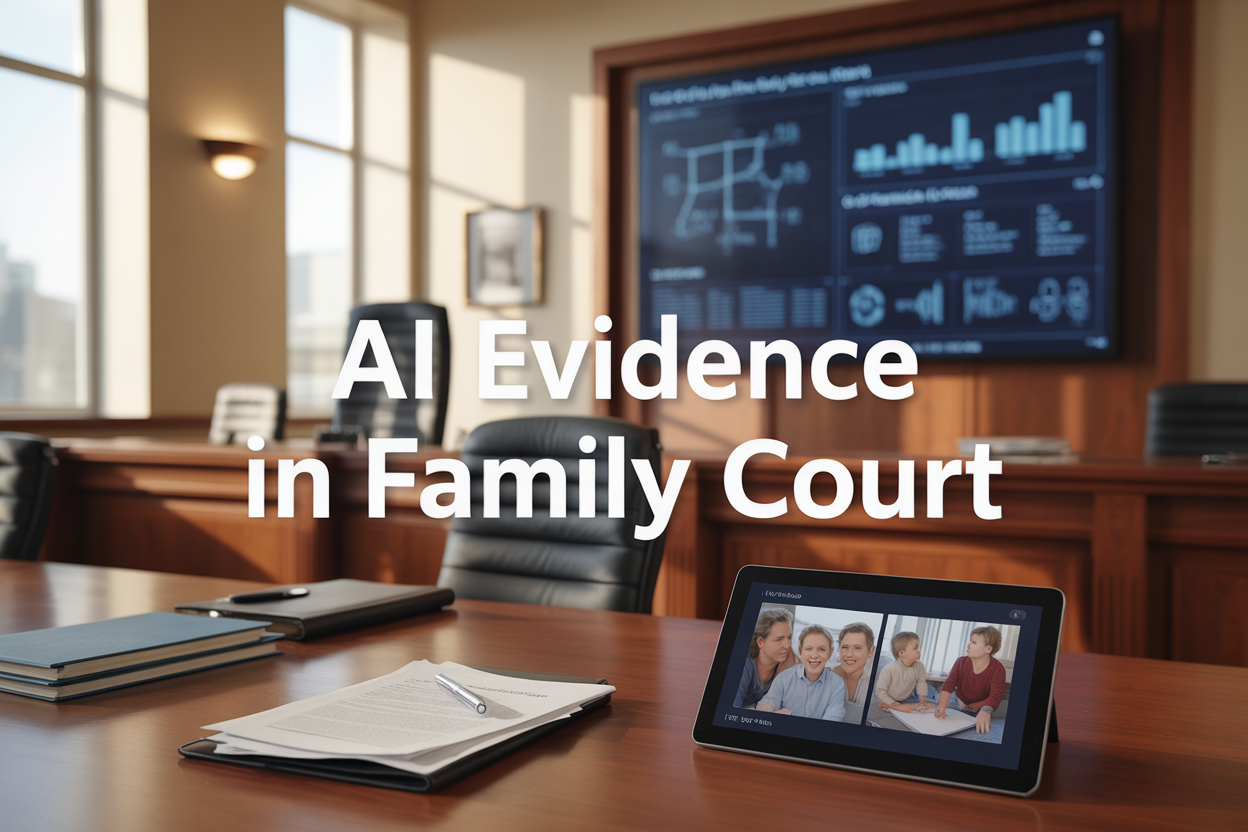Technology is revolutionizing how family courts handle custody battles, with AI evidence in family court and custody battles technology changing everything from evidence collection to final decisions. Parents, family lawyers, and legal professionals need to understand these rapid changes as digital evidence in family law becomes the new standard in courtrooms across the country.
This guide is for divorcing parents, family attorneys, and anyone navigating custody proceedings who wants to understand how technology impacts their case. Whether you’re gathering evidence through apps and social media or trying to make sense of AI-powered recommendations, knowing these tools can make or break your custody outcome.
We’ll explore how AI analytics predict optimal custody arrangements using data patterns that human judges might miss, examine the tricky legal admissibility challenges for digital evidence that lawyers face when presenting tech-based proof, and discuss the critical balance between using child custody digital tools effectively while protecting your family’s privacy in an increasingly connected world.
The days of custody decisions based solely on witness testimony are fading fast. Today’s family courts rely on smartphone data, social media activity, and AI-powered analysis to determine what’s best for children.
Understanding AI Evidence in Modern Family Court Proceedings
Digital footprints that influence custody decisions
Modern family courts are getting smarter about examining the digital traces parents leave behind. Every click, swipe, and online interaction creates a permanent record that judges now consider when making custody decisions. AI evidence in family court has transformed how attorneys build their cases, pulling together scattered digital breadcrumbs to paint comprehensive pictures of parental behavior.
Search histories reveal personal interests and priorities. Browser data shows whether parents research child development resources or spend time on questionable websites. App usage patterns demonstrate how much time parents dedicate to entertainment versus family-focused activities. Even online shopping habits become relevant – frequent purchases of educational toys and books suggest involved parenting, while excessive spending on personal luxuries might indicate misplaced priorities.
Dating app activity during separation proceedings carries significant weight in custody battles, as technology analysis reveals. Courts examine when accounts were created, usage frequency, and whether children were present during dates arranged through these platforms. Email communications with schools, doctors, and extracurricular coordinators show which parent stays actively engaged in their child’s daily life.
Text messages and social media posts as parental fitness indicators
Text conversations between parents and children offer courts direct insight into the quality of the relationship. AI algorithms analyze communication patterns, identifying positive engagement versus neglectful or inappropriate interactions. Messages showing consistent check-ins about homework, emotional support during difficult times, and a genuine interest in children’s activities strengthen custody arguments.
Social media presence has become a crucial battleground in custody proceedings. Posts celebrating children’s achievements, sharing proud parenting moments, and documenting quality time together demonstrate commitment. Conversely, content focusing exclusively on nightlife, dating, or complaints about parenting responsibilities raises red flags for judges.
Digital evidence family law experts examine posting timestamps to understand parenting schedules. Parents who share photos and updates during their designated custody time show active involvement. Those whose social media goes silent during their parenting periods might face questions about actual engagement levels.
Comments and reactions on posts reveal co-parenting dynamics. Public disputes, negative remarks about the other parent, or inappropriate disclosure of private family matters can severely damage custody cases. Courts particularly scrutinize content that exposes children to adult relationship drama or conflict.
Location tracking data revealing parenting patterns
GPS data from smartphones creates detailed maps of parenting behavior that courts can examine. Artificial intelligence custody cases now routinely include location evidence showing whether parents actually spend time at locations beneficial to children – schools, libraries, parks, medical appointments, and extracurricular activities.
Frequent visits to bars, casinos, or other adult-oriented venues during custody periods raise concerns about judgment and priorities. Conversely, regular trips to educational venues, family-friendly activities, and child-focused locations demonstrate a commitment to providing enriching experiences.
Travel patterns reveal consistency in school drop-offs and pick-ups. Parents who maintain reliable schedules show stability and reliability that courts value in custody arrangements. Irregular patterns or frequent absences during custody time suggest potential neglect or delegation of parental responsibilities to others.
Location data also exposes violations of custody agreements or restraining orders. Courts can verify whether parents respect boundaries, avoid prohibited locations, or maintain an appropriate distance from former partners when required.
Financial digital records exposing child support capabilities
Banking apps, digital payment platforms, and online financial accounts provide transparent views into parental financial stability. AI analytics custody arrangements increasingly rely on this data to assess both child support capabilities and spending priorities that impact children’s welfare.
Automated transaction categorization reveals spending patterns that courts examine closely. Regular payments for children’s needs – medical bills, school supplies, extracurricular fees – demonstrate financial commitment to parenting. Entertainment spending, luxury purchases, or gambling activities during periods when child support payments are late paint concerning pictures.
Digital subscription services tell stories about household priorities. Educational platform subscriptions, family-friendly streaming services, and children’s app purchases show investment in child development. Adult-oriented subscriptions without corresponding child-focused spending suggest misplaced financial priorities.
Credit monitoring apps and debt management platforms provide insight into overall financial health. Parents struggling with debt or poor credit might face questions about their ability to provide stable environments, while those demonstrating responsible financial management strengthen their custody positions. Courts examine whether financial struggles result from circumstances beyond control or poor decision-making that could affect children’s security.
Game-Changing Technology Tools Transforming Custody Cases
Smartphone Monitoring Apps Tracking Co-Parenting Compliance
Modern custody battles technology has revolutionized how courts monitor parental compliance with custody orders. Specialized apps like OurFamilyWizard, Talking Parents, and AppClose now serve as digital witnesses in family court proceedings, capturing every interaction between co-parents. These platforms automatically timestamp messages, track response times, and maintain unalterable records of communication patterns.
The data collected proves invaluable when demonstrating parental cooperation or documenting violations. Courts can review concrete evidence showing who consistently cancels visits, ignores communication attempts, or fails to follow agreed-upon schedules. GPS tracking features within these apps also verify pickup and drop-off times, eliminating disputes about punctuality or missed exchanges.
Privacy concerns arise as these monitoring systems capture intimate family dynamics, but their legal weight often outweighs personal discomfort. Judges increasingly rely on this digital evidence that family law professionals present, as it provides objective documentation of subjective claims about parental behavior.
Video Surveillance Evidence Proving Neglect or Abuse
Security cameras, nanny cams, and doorbell cameras have become powerful tools in custody disputes. Video evidence captures real-time interactions between parents and children, providing courts with unfiltered glimpses into home environments. Ring doorbells document who arrives for scheduled visits, while interior cameras can reveal concerning behavioral patterns or validate abuse allegations.
The emotional impact of video evidence on judges and juries cannot be overstated. Written testimonies pale in comparison to actual footage showing a parent’s inappropriate behavior or neglectful actions. However, recording laws vary significantly by state, and secret surveillance can backfire legally if obtained without proper consent.
Smart home technology integration has expanded surveillance capabilities beyond traditional cameras. Voice assistants accidentally record heated arguments, while smart locks track entry patterns. This ambient data collection creates comprehensive behavioral profiles that family court technology experts analyze for patterns of instability or danger to children.
Digital Calendar Systems Documenting Visitation Schedules
Court-approved scheduling platforms have replaced handwritten agreements, creating transparent records of custody arrangements. Apps like Custody X Change and 2Houses automatically generate reports showing compliance rates, missed visits, and schedule modification requests. These systems eliminate the “he said, she said” disputes that once plagued family courts.
The data visualization features help judges quickly identify patterns of non-compliance. Color-coded calendars highlight missed visits, while automated notifications ensure both parents receive equal access to schedule information. When disputes arise, courts can instantly access months of historical data showing which parent consistently follows court orders.
Integration with email and text messaging systems creates additional layers of accountability. Parents receive automatic reminders about upcoming visits, while the system logs whether messages were read. This technological oversight has significantly reduced scheduling conflicts and improved co-parenting compliance rates across jurisdictions that have adopted digital solutions.
Communication Platforms Creating Transparent Parent-Child Interactions
Court-mandated communication platforms now facilitate and monitor parent-child interactions in high-conflict cases. These systems record video calls, archive text conversations, and track emotional indicators in digital communications. AI analytics custody arrangements benefit from this data, as algorithms analyze communication patterns to assess relationship quality and parental influence.
Platforms like Zoom for supervised visitation create safe spaces for parent-child contact while generating admissible evidence about the quality of interaction. Court-appointed monitors can review recordings to evaluate parental behavior, identify attempts at manipulation, or document positive relationship-building efforts. The permanent record protects both children and parents from false accusations while ensuring accountability.
Advanced features include sentiment analysis of written communications, automatic flagging of inappropriate content, and real-time intervention capabilities when conversations become concerning. This AI evidence in family court helps judges make informed decisions about expanding or restricting parental access based on demonstrated communication patterns rather than conflicting testimonies.
Legal Admissibility Challenges for Digital Evidence
Authentication Requirements for Social Media Screenshots
Social media posts have become crucial pieces of evidence in custody battles, but getting them admitted in court presents significant hurdles. Screenshots of Facebook messages, Instagram stories, or text conversations can reveal patterns of behavior, but judges need solid proof that these digital captures are genuine and unaltered.
The authentication process requires more than just printing out a screenshot. Courts demand evidence showing who created the content, when it was posted, and that nothing was modified between creation and presentation. This means providing metadata, server logs, or testimony from witnesses who saw the original posts. Many parents lose valuable evidence because they failed to document the digital trail properly.
Third-party authentication services have emerged to solve this problem, using specialized software to capture and verify social media content with cryptographic signatures. These tools create legally defensible records that satisfy court requirements, but they require foresight – evidence must be preserved using proper methods before disputes escalate.
The burden of proof remains high because digital content is easily manipulated. Courts have rejected countless screenshots due to poor authentication, even when the content clearly showed concerning behavior. Competent attorneys now work with digital forensics experts from the case’s beginning to ensure all AI evidence in family court meets admissibility standards.
Privacy Laws Limiting Access to Personal Digital Data
Digital evidence admissibility in custody cases crashes headfirst into privacy protections that shield personal information from unauthorized access. Parents cannot simply hack into their ex-partner’s accounts or secretly monitor their devices, even when seeking evidence of harmful behavior toward children.
Federal wiretapping laws and state privacy statutes create complex boundaries around what digital information can be legally obtained and presented in family court proceedings. Recording phone calls without consent, accessing password-protected accounts, or installing tracking software on devices belonging to the other parent typically violates these protections, making any evidence gathered inadmissible.
The situation becomes murkier when dealing with shared devices, family computers, or accounts that both parents previously accessed. Courts examine the reasonable expectation of privacy, considering factors like who owned the device, whether passwords were shared, and whether there was mutual access during the relationship.
Children’s privacy rights add another layer of complexity. Parents generally cannot secretly record their minor children or monitor their digital activities to gather evidence against the other parent without court approval. These restrictions protect family privacy but can frustrate parents who believe they need this evidence to defend their children’s welfare.
Some courts allow limited digital monitoring when there are credible safety concerns. Still, these exceptions require proper legal procedures and often need advance judicial approval to ensure the evidence will be admissible later.
Chain of Custody Protocols for Electronic Evidence
Electronic evidence requires meticulous handling to maintain its integrity from collection through court presentation. Unlike physical evidence, digital files can be copied perfectly, but this creates challenges in proving authenticity and preventing tampering throughout the legal process.
Proper chain of custody documentation must track every person who handled the evidence, what actions they took, and when transfers occurred. Digital forensics experts use specialized tools to create exact copies of devices or files while generating hash values – unique digital fingerprints that detect any subsequent changes to the data.
Time stamps become critical in custody battles where the timing of events matters. Courts need proof that digital evidence reflects conditions at specific moments, not altered versions created later. Professional forensics teams document system clocks, time zones, and synchronization issues that could affect timestamp accuracy.
The challenge multiplies when dealing with cloud-based evidence stored across multiple servers and jurisdictions. Email accounts, photo storage, and social media platforms create complex digital trails that require sophisticated collection methods to preserve admissibility.
Family law attorneys increasingly rely on certified digital forensics professionals rather than attempting evidence collection themselves. These experts understand the technical requirements and legal standards necessary to withstand courtroom challenges, ensuring that crucial electronic evidence is not excluded on procedural grounds when custody decisions are at stake.
How AI Analytics Predict Optimal Custody Arrangements
Algorithm-based risk assessment tools for child safety
Family courts are turning to sophisticated algorithms that analyze multiple data points to evaluate potential risks to children. These AI-powered systems process information from child protective services records, police reports, medical histories, and social media activity to create comprehensive risk profiles. The technology can identify patterns that human evaluators might miss, such as subtle correlations between a parent’s online behavior and documented incidents.
AI custody prediction algorithms analyze factors such as substance abuse history, domestic violence records, and financial stability using advanced data mining techniques. These tools cross-reference public records, court documents, and even analyze speech patterns during depositions to assess truthfulness and emotional stability. Some systems incorporate real-time monitoring capabilities that track compliance with court orders, providing judges with objective metrics rather than relying solely on subjective testimony.
Behavioral pattern analysis identifying suitable guardians
Machine learning systems excel at detecting behavioral patterns that indicate parenting fitness. These AI analytics custody arrangements tools analyze communication patterns between parents and children, examining tone, frequency, and content of text messages and emails. The technology can identify signs of manipulation, emotional abuse, or neglect through linguistic analysis and communication timing patterns.
Advanced behavioral assessment algorithms evaluate social interactions, work performance, and lifestyle choices by processing data from various sources. Some courts utilize systems that analyze video footage from supervised visitations, measuring body language, emotional responses, and the quality of interaction between parents and children. These tools provide quantifiable metrics for qualities traditionally assessed through subjective observation.
Predictive modeling for successful co-parenting outcomes
Digital evidence in family law now includes predictive models that forecast the likelihood of successful co-parenting relationships. These systems analyze historical data from thousands of custody cases, identifying factors that correlate with positive outcomes. The models consider variables like geographic proximity, communication styles, conflict resolution history, and each parent’s willingness to facilitate the other’s relationship with the child.
Machine learning algorithms process psychological evaluations, mediation records, and past compliance with custody agreements to predict future cooperation levels. Some systems incorporate real-time data feeds that monitor ongoing interactions between co-parents, adjusting predictions based on evolving relationship dynamics and compliance patterns.
Data-driven recommendations for visitation schedules
Tech family court proceedings increasingly rely on algorithms that optimize visitation schedules based on multiple variables. These systems consider children’s school calendars, extracurricular activities, both parents’ work schedules, and travel distances to create practical arrangements that work for everyone. The AI analyzes historical data to identify schedule patterns that maximize stability and minimize disruption to children’s routines.
Advanced scheduling algorithms factor in seasonal variations, holiday traditions, and special events while maintaining fairness between parents. Some systems continuously learn from feedback data, adjusting recommendations based on the success or failure of previous arrangements. This dynamic approach enables courts to create more effective custody schedules that can adapt to changing family circumstances.
Machine learning applications evaluating home environments
Artificial intelligence custody cases now include sophisticated home environment assessments through various technological means. AI systems analyze property records, neighborhood safety statistics, school district quality ratings, and proximity to essential services. Some applications process images from home visits, evaluating safety hazards, cleanliness, and the presence of appropriate child-proofing measures using computer vision technology.
Machine learning tools assess the stability of living situations by analyzing factors such as rental history, mortgage payments, utility records, and changes in household composition. These systems can predict the likelihood of future relocations or housing instability that might disrupt children’s lives. Advanced applications even consider environmental factors, such as air quality, noise levels, and access to recreational facilities, when evaluating the suitability of each parent’s home environment for child-rearing.
Protecting Children’s Privacy in Tech-Heavy Court Cases
Safeguarding minors’ digital information during proceedings
When technology and family court intersect, protecting children’s sensitive information becomes a complex challenge that requires careful navigation. Digital evidence in custody battles often contains deeply personal details about a child’s daily activities, medical records, educational performance, and behavioral patterns collected through various AI evidence in family court systems.
Courts must establish strict protocols for handling children’s digital footprints, including social media activity, educational app data, health monitoring information, and location tracking records. These protective measures extend beyond simple redaction – they require specialized secure systems that limit access to only essential personnel while maintaining the integrity of the evidence.
Many jurisdictions now mandate that children’s digital information undergo extra layers of encryption and restricted viewing protocols. Legal teams working with custody battles technology must demonstrate specific need-to-know requirements before accessing any child-related digital evidence. Some courts have implemented secure viewing rooms where family law practitioners can review sensitive materials without creating additional digital copies.
The challenge becomes more complex when dealing with AI analytics custody arrangements that process behavioral data from children. Courts must ensure that raw data containing personal identifiers gets properly anonymized while preserving the analytical value needed for custody determinations. This often requires working with specialized tech experts who understand both legal requirements and privacy protection protocols.
Balancing transparency needs with child protection requirements
Family courts face a delicate balancing act between providing parents with access to evidence and shielding children from potential harm. This tension becomes particularly acute when dealing with artificial intelligence custody cases, where algorithms analyze vast amounts of personal data about family dynamics.
Transparent proceedings traditionally allow both parents to examine all evidence presented in court. However, when this evidence includes detailed behavioral analytics, psychological assessments generated through AI, or sensitive communications involving the child, courts must carefully consider what information serves the case versus what might compromise the child’s well-being.
Some courts have adopted a tiered disclosure system for tech family court proceedings. Essential findings and conclusions from AI analysis get shared with all parties, while the underlying raw data remains restricted to court-appointed experts and judges. This approach maintains procedural fairness while protecting children from having their most private moments dissected in detail by parents who may be experiencing high-conflict emotions.
The rise of digital evidence in family law has also prompted courts to consider sealed proceedings or partial confidentiality orders more frequently. When AI systems generate detailed personality profiles or predictive behavioral models about children, judges often limit how this information can be shared, stored, or referenced outside the immediate custody case.
Long-term implications of digital evidence on children’s futures
The digital footprints created during custody proceedings don’t simply disappear when cases conclude. Children involved in technology-heavy custody battles may find their most formative years documented in unprecedented detail, creating lasting implications that extend well into adulthood.
AI custody prediction algorithms often create comprehensive behavioral profiles that could theoretically follow a child throughout their life. These digital records might include academic performance predictions, social interaction patterns, emotional regulation assessments, and other deeply personal analytical insights. Courts must consider how to protect these records from future misuse while preserving them for potential appeals or case modifications.
Many legal experts advocate for automatic expungement protocols that would seal or destroy certain types of digital evidence once children reach adulthood. However, this approach conflicts with the need to maintain court records and the possibility that custody arrangements might require future modifications based on changed circumstances.
The psychological impact on children who grow up knowing their behavior has been extensively monitored and analyzed presents another concern. Family law technology trends show increasing sophistication in child monitoring capabilities, but the long-term effects of growing up under such scrutiny remain largely unknown.
Some progressive courts now require “digital impact statements” that consider how the collection and analysis of a child’s digital information might affect their development, relationships, and future opportunities. These assessments help judges weigh the immediate benefits of comprehensive digital evidence against potential long-term consequences for the child’s privacy and autonomy.
The landscape of custody battles has shifted dramatically, with AI and digital evidence becoming central players in family court proceedings. Parents now find themselves navigating a world where social media posts, location data, and predictive analytics can make or break their case. While these technological advances offer unprecedented insights into parenting patterns and child welfare considerations, they also raise serious questions about privacy, data accuracy, and the human element that should remain at the heart of custody decisions.
As family courts continue to embrace these digital tools, parents must become more aware of their digital footprints and how technology may impact their cases. The key is finding the right balance between leveraging helpful AI insights and protecting children’s privacy rights. If you’re facing a custody battle, work closely with legal professionals who understand both traditional family law and emerging technology trends. Your children’s future may depend on how well you navigate this new digital frontier while keeping their best interests as the top priority.
At Lass Law, our Divorce & Family Law Attorneys in North County San Diego provide the experienced support families need during life’s most challenging times. Whether you’re seeking guidance from a Family Law Attorney in Oceanside, working through Divorce Law concerns, or consulting a Family Law Attorney in Vista, our team delivers clear strategies and compassionate representation. Explore how our Family Law services can help protect your future.






